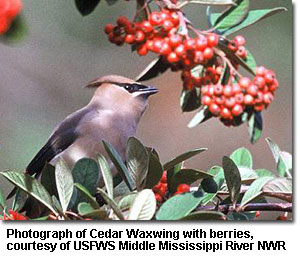Cedar Waxwing
(Bombycilla cedrorum)
 Description & Range:
Description & Range:
Grayish brown in color with a black mask, crested head and unique hard red wax – like tips on wing feathers. The "Cedar- bird" as it is sometimes known is slightly smaller than a robin at 6 1/2” to 8” in length. Usually found in flocks unless nesting. Males and females are similar, but uveniles are more brown above, streaked below, and lack the red wax wing tips.
Found year round in Maryland. Breeds statewide, with highest concentrations in western and central Maryland. Waxwing flocks are highly erratic.
Habitat:
Waxwings prefer open woodlands, orchards, hedgerows and residential areas that have berry-bearing trees or shrubs.
Diet:
Almost 90% of the waxwings food is fruit. Cedar berries are a major source, followed by cherry, dogwood, blackberry, chokeberry, hackberry, mulberry, serviceberry, viburnums, grapes, crab apples, mountain ash, elderberry, holly, greenbriar, and poison ivy, The other 10% of the birds diet consists of insects, such as beetles, ants, grasshoppers crickets and mayflies. Waxwings will catch insects in flight.
Reproduction:
Waxwings nest later in the summer, July to August, when there is an ample supply of berries. Between 4 to 6 blue- gray eggs with brown or black spots are found in a cup like nest made of twigs and grass in a tree 15’ to 30 ‘ from the ground They prefer a conifer in an open site. Although both sexes help build the nest, the female incubates the eggs for 12 days. After hatching, the young birds stay in the nest about 17 days. Both adult sexes help feed the nestlings. Waxwings can store berries in a pouch in their throat, which they can regurgitate berries into nestlings’ mouths. Most waxwings only have one brood per season. They will not reuse an old nest nor will they use a nesting box or platform.
Sounds:
High-pitched, sounds like "seee" or a high pitched wheeze. They make these sounds as they feed , fly or land.
Did you Know:
Cedar Waxwings feed in flocks on berry trees and are known to gorge themselves where they become almost too heavy to fly. They are also known to become drunk on overripe fruit, causing them to fly erratically.